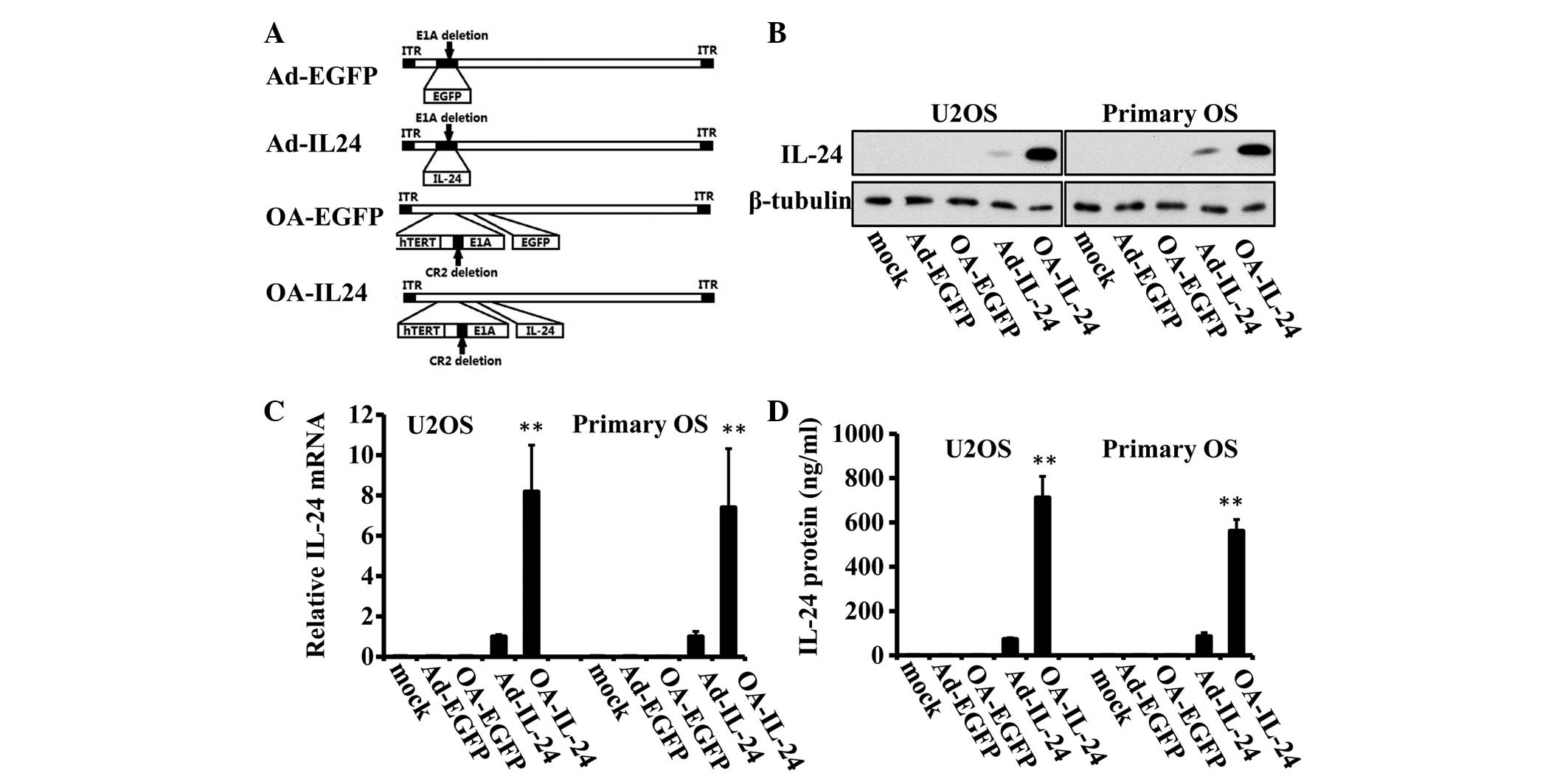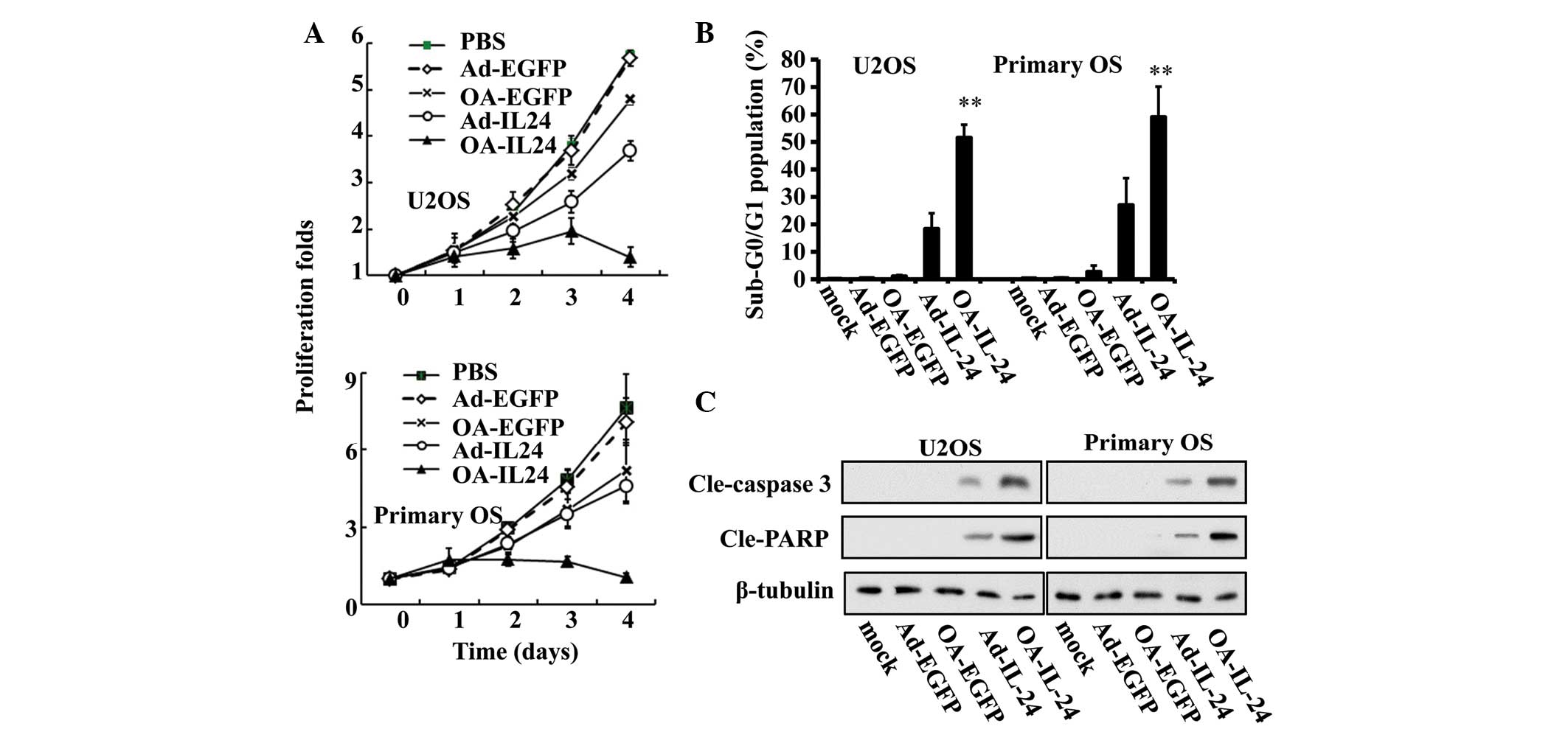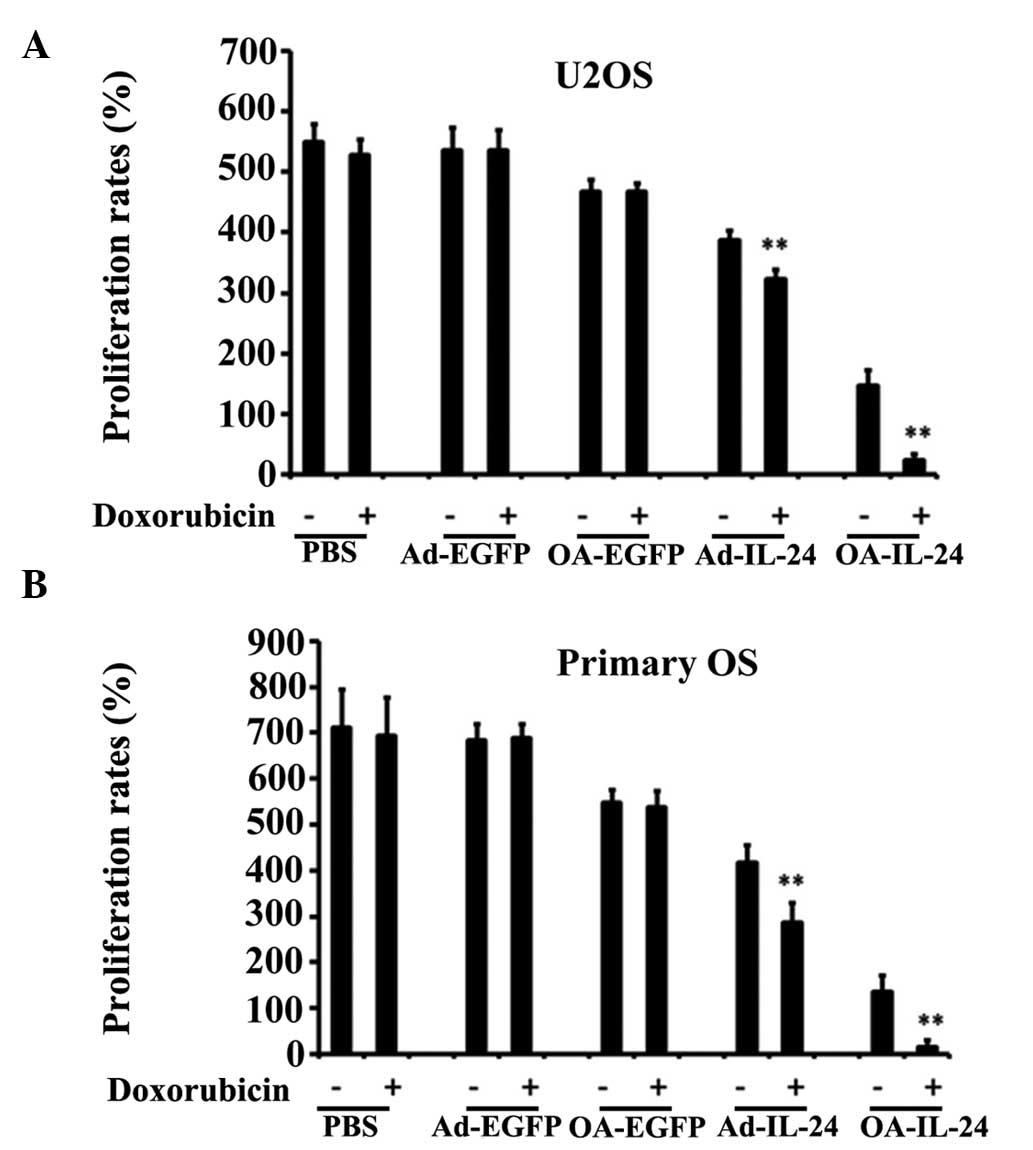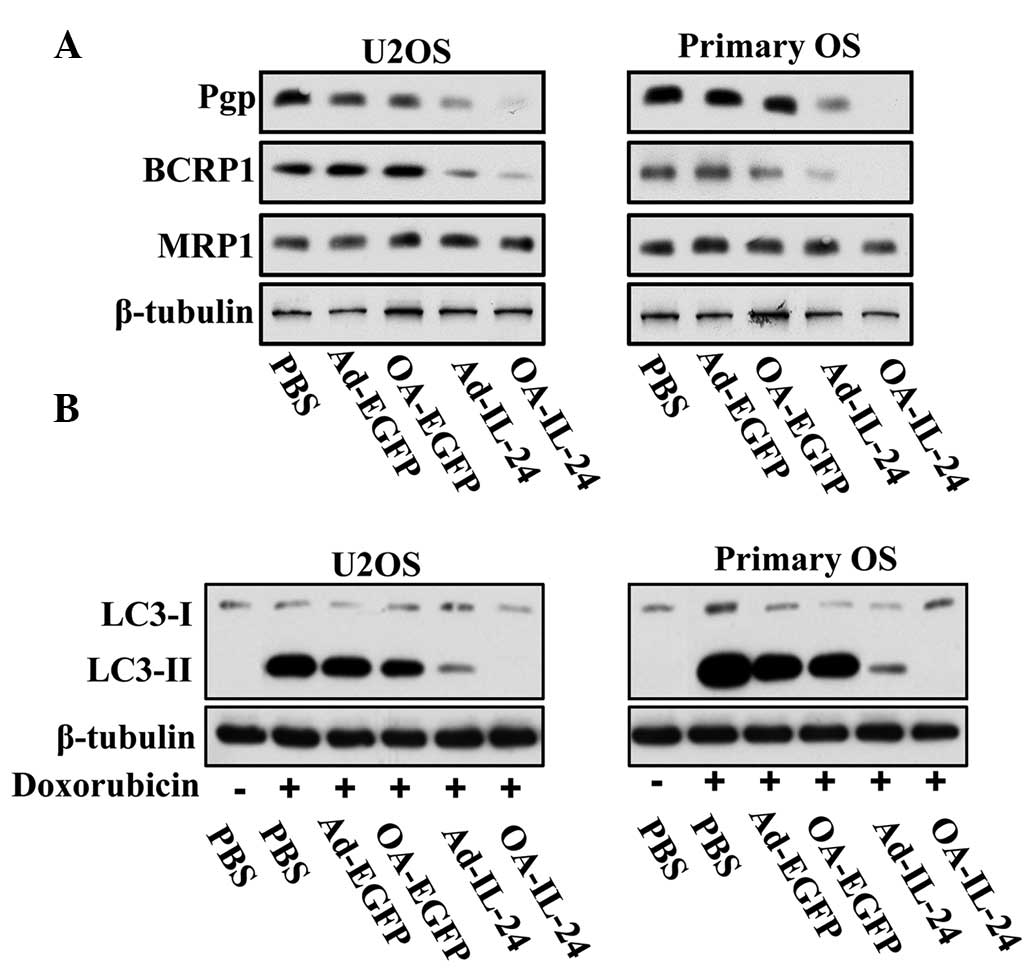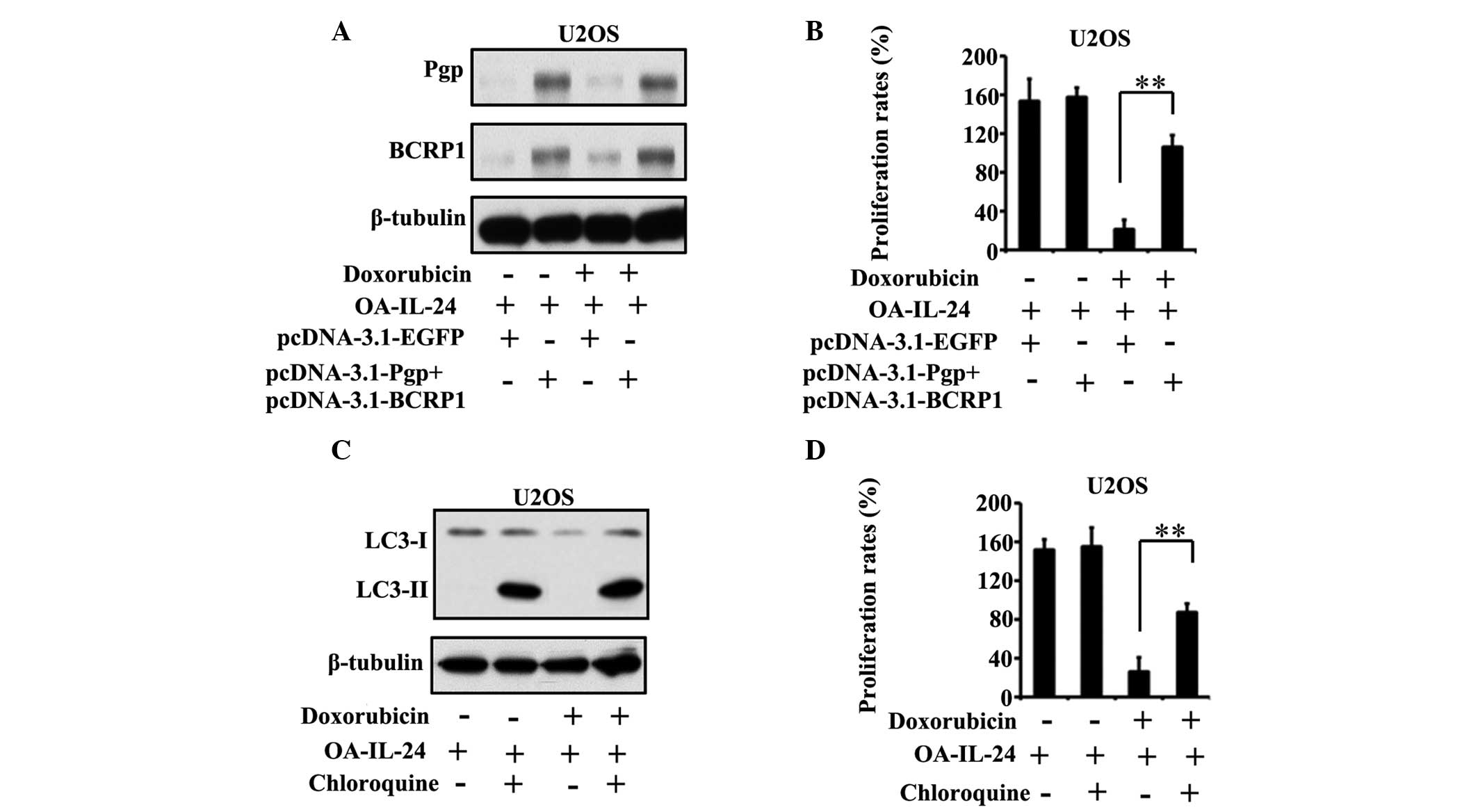Oncolytic adenovirus‑mediated mda‑7/IL‑24 expression suppresses osteosarcoma growth and enhances sensitivity to doxorubicin
Retraction in: /10.3892/mmr.2021.12476
- Authors:
- Published online on: August 5, 2015 https://doi.org/10.3892/mmr.2015.4180
- Pages: 6358-6364
Abstract
Introduction
Osteosarcoma (OS) is one of the most common types of malignancy with a poor prognosis (1). The altered expression of oncogenes or tumor suppressors has an important role in the progression, invasion and metastasis of OS (1). Therefore, gene therapy is a promising strategy for the treatment of OS (2).
Melanoma differentiation-associated gene 7 (mda7)/interleukin (IL)-24 belongs to the IL-10 cytokine family and induces apoptosis in various types of cancer by binding to two heterodimeric receptors, IL-20R1 and IL-22R1 (3). The expression of IL-20R1 and IL-22R1 in cancer cells ensures the fact that IL-24 may be used as an effective anti-tumor agent in future clinical cancer therapy (4). In fact, IL-24 has been demonstrated to exert anti-tumor activity in certain types of cancer, including hepatocellular carcinoma (5) and lung cancer (6). Notably, adenovirus-mediated IL-24 delivery has been demonstrated to suppress the growth of OS (7). However, the efficacy of IL-24 is relatively limited in OS, since the expression level of IL-24 cannot meet clinical demands.
Unlike the current nonreplicative adenoviral vector, oncolytic adenoviruses are able to proliferate selectively in cancer cells, due to the action of their tumor-specific promoter. It is worth noting that oncolytic adenoviruses have no significant cytotoxicity to normal tissues. The effect of these oncolytic adenoviruses has been verified in various types of cancer in vitro and in vivo (8). Of note, oncolytic adenoviruses can also be used for gene therapy by delivering a tumor suppressor into cancer cells. During the replication of vectors, the copies of carried genes are also increased, allowing a higher expression level of inserted therapeutic genes.
In the present study, a recombinant oncolytic adenovirus for inducing a high expression of IL-24 (OA-IL-24) was generated. The inhibitory effect of OA-IL-24 on the growth of osteosarcoma was investigated in the current study, in addition to its influence on the sensitivity of OS cells to doxorubicin.
Materials and methods
Cell lines and culture
The human OS cell line, U2OS, was purchased from the American Type Culture Collection (Manassas, VA, USA). The human embryonic kidney (HEK) cell line HEK-293 was obtained from Microbix Biosystems, Inc. (Toronto, Canada). The cells were cultured in Dulbecco's modified Eagle's medium supplemented with 10% fetal bovine serum (FBS; Gibco-BRL, Gaithersburg, MD, USA) and 4 mM L-glutamine at 37°C in a humidified incubator in an atmosphere of 5% CO2.
Primary culture
In the present study, primary OS cells were used to assess the efficiency of adenoviral vectors, Ad-IL-24 and OA-IL-24. Primary OS cells were obtained with written informed consent from patients following the previously described procedures (9) approved by the Ethics Committee of Jilin University (Changchun, China). Briefly, fresh OS samples were obtained from OS patients during surgery and then were directly placed in media with 20% FBS, minced with sterile scissors and digested for 1 h. Subsequently, the separated cells were centrifuged at 320 × g for 10 min and then were suspended in media containing 20% FBS according to routine procedures (9).
Adenoviruses, chemicals and plasmids
Two replication-deficient adenoviruses, Ad-enhanced green fluorescent protein (EGFP) and Ad-IL24, were kindly provided by Dr Jing Xu (The First People's Hospital of Yunnan Province, Kunming, China). OA-EGFP and OA-IL-24 were produced as described below. A plasmid containing human telomerase reverse transcriptase promoter-regulated mutant E1A and a cytomegalovirus promoter-regulated expression cassette was also generously provided by Dr. Xu. EGFP and IL-24 genes were inserted into the cassette at NotI and XhoI sites. The two recombinant plasmids were then transduced into the BJ5183 E. coli strain together with pAd Easy-1, which encodes adenoviral genomic sequences, for subsequent homogenous recombination. The recombinant vectors were then transfected into HEK-293 cells following PacI digestion. The produced adenoviruses were termed OA-EGFP and OA-IL-24. The construction of adenoviral vectors used in the present study is depicted in Fig. 1A. These adenoviruses were then purified using a CsCl gradient ultracentrifugation method. The titers of the adenoviruses were determined using a tissue culture infectious dose 50 assay.
Doxorubicin and chloroquine were purchased from Sigma-Aldrich (St. Louis, MO, USA). The plasmids used in the present study, pcDNA3.1-EGFP, pcDNA3.1-Pgp and pcDNA3.1-BCRP1, were all provided by Dr Jing Xu (The First People's Hospital of Yunnan Province).
mRNA detection
Total RNA was extracted from the cells using TRIzol reagent (Invitrogen Life Technologies, Grand Island, NY, USA) according to the manufacturer's instructions. Reverse transcription quantitative polymerase chain reaction (RT-qPCR) was performed according to the manufacturer's instructions of the RevertAid™ First Strand cDNA Synthesis kit (Fermentas, Pittsburgh, PA, USA) to generate cDNA. Subsequently, qPCR was performed with SYBR premix Ex Taq (RR420A; Takara Bio Inc., Otsu, Japan) on an Applied Biosystems 7300 Real-Time PCR System supplied with analytical software (AutoCaller™ Real-time PCR Analysis Software, version 1.0; Applied Biosystems, Pittsburgh, PA, USA). GAPDH was used as an endogenous reference. The primer sequences used were as follows: IL-24, forward 5′-TCTGCAGGGACAGAGCATT-3′; and reverse 5′-CGAGTGTGGGTGGGAAATG-3′; GAPDH, forward 5′-TCAGTGGTGGACCTGA-3′ and reverse 5′-TGCTGTAGCCAAATTC-3′.
ELISA
A two-antibody sandwich ELISA was used to detect human IL-24 in the present study. The following antibodies were used: Mouse monoclonal anti-human IL-24 antibody (1:200; MAB1965; R&D Systems, Minneapolis, MN, USA), goat polyclonal anti-human IL-24 antibody (1:500; AF1965; R&D Systems) and polyclonal peroxidase-conjugated rabbit anti-goat IgG (1:500; HAF017; H&L; R&D Systems). The absorbance was read at a wavelength of 450 nm using a 550 Microplate Reader (Bio-Rad Laboratories, Inc., Hercules, CA, USA). The concentration of IL-24 was determined according to a standard curve.
Cell proliferation assay
U2OS (5×103 per well) and primary OS cells were plated in 96-well plates. Overnight, the indicated adenoviruses or doxorubicin were added into each well. At the indicated time points, 3-(4,5-dimethylthiazol-2-yl)-2,5-diphenyltetrazolium bromide (MTT; 1 mg/ml) was added to the cultures. After 4 h incubation, the media were removed and dimethyl sulfoxide was added into each well. The absorption values of each well were measured on a microplate reader (Infiniate 200 PRO; Tecan, Männedorf, Switzerland). The proliferation rate was calculated according to the following formula: Proliferation rate (folds) = (absorption values of tested well - absorption values of empty well) / (absorption values of control well - absorption values of empty well).
Detection of cell apoptosis
The rates of apoptotic cells were determined by flow cytometric analysis of the sub-G0/G1 population. Cells were fixed in cold 70% ethanol for 1 h and then incubated with 10 mg/ml RNase A at 37°C for another 1 h. The cells were stained with propidium iodide (PI; 200 mg/ml), followed by flow cytometric analysis of the sub-G0/G1 population (Aria II; BD Biosciences, San Jose, CA, USA). A total of 1×105 cells were counted for each sample.
Immunoblot assay
The protein was extracted from cells with M-PER® Mammalian Protein Extraction Reagent (Thermo Fisher Scientific, Rockford, IL, USA). Immunoblot analysis was performed according to routine protocols (10). Briefly, the isolated proteins were separated by polyacrylamide gel electrophoresis and then transferred onto 0.45 µm nitrocellulose membranes. The membranes were blocked with 5% fat-free dry milk in phosphate-buffered saline (PBS) and incubated with primary antibodies. Overnight, the membrane was incubated with corresponding secondary antibodies and visualized with SuperSignal West Dura Extended Duration Substrate (Thermo Fisher Scientific). All primary antibodies (excluding anti-IL-24) were purchased from Cell Signaling Technology, Inc. (Beverly, MA, USA). The Cell Signaling Technology antibodies (1:1,000) used were as follows: Monoclonal rabbit anti-human cleaved poly (ADP-ribose) polymerase (#5625), monoclonal rabbit anti-human cleaved caspase-3 (#9664); polyclonal rabbit anti-human β-tubulin (#2146); monoclonal rabbit anti-human LC3B (#3868); monoclonal mouse anti-human Pgp (#5640); polyclonal rabbit anti-human BCRP1 (#4477); monoclonal rabbit anti-human MRP1 (#14685). The signal intensity was measured using a chemiluminescent detection system (Pierce Biotechnology Inc.).
Animal experiment
The procedures for animal experiments were approved by the Committee on the Use and Care of Animals (Jilin University, Changchun, China). U2OS tumor xenografts were established by subcutaneously injecting 5×106 cells into the left flanks of 4–6-week-old BALB/c nude mice (n=30; Shanghai Institutes for Biological Sciences, Shanghai, China). When tumors reached between 7 and 10 mm in diameter, 30 mice were randomly divided into five groups (PBS; n=6; Ad-EGFP, n=6; Ad-IL-24, n=6; OA-EGFP, n=6; OA-IL-24, n=6). The established tumors were intratumorally administered with 100 µl PBS alone or with 1×109 pfu of Ad-EGFP, Ad-IL-24, OA-EGFP and OA-IL-24. The diameters of tumors were measured with calipers and the tumor volume was calculated using the following formula: Tumor volume (mm3) = maximal length (mm) × (perpendicular width (mm))2 / 2. During the experiments, no mice died from tumor loading.
Histological staining and apoptosis detection in tumor xenografts
One animal was randomly selected from each group for histological staining of IL-24 or apoptosis detection assays, 7 days after administration. Their tumors were harvested and fixed with formalin. Histological staining was performed on formalin-fixed, paraffin-embedded tissue sections using the streptavidin biotin peroxidase complex method. Goat polyclonal anti-human IL-24 antibody (1:100; sc-8704; Santa Cruz Biotechnology, Inc., Santa Cruz, CA, USA) was used to stain IL-24 protein in tumors. The sections were counterstained with hematoxylin. Apoptosis detection was performed using a TUNEL Apoptosis Detection kit (Millipore, Boston, MA, USA) according to the manufacturer's instructions.
Statistical analysis
All statistical tests in the present study were two-tailed Student's test. SPSS software, version 19.0 (IBM SPSS, Armonk, NY, USA) was used for analysis. P<0.05 was considered to indicate a statistically significant difference.
Results
OA-IL-24 leads to a higher expression of IL-24 compared with Ad-IL-24 in OS cells
A recombinant oncolytic adenovirus expressing IL-24 (OA-IL-24) was generated and a recombinant proliferation-deficient vector containing IL-24, Ad-IL-24, as well as OA-EGFP and Ad-IL-24, were used as controls (Fig. 1A).
Initially, the expression level of IL-24 was compared in U2OS OS cell lines and primary OS cells between different adenoviral vectors. The immunoblot assay indicated that OA-IL-24 expressed higher levels of IL-24 in these two cells compared with Ad-IL-24 (Fig. 1B). The analysis of mRNA expression levels also confirmed the advanced expression capacity of oncolytic adenovirus for IL-24 expression (Fig. 1C). Consistently, ELISA assays revealed that the quantity of IL-24 secreted into media was significantly higher in OA-IL-24-infected cells, compared with Ad-IL-24 (6.55–9.71-fold; Fig. 1D).
The above data suggested that the oncolytic adenovirus induces a higher expression of IL-24 compared with the replication-deficient adenovirus.
OA-IL-24 suppresses the proliferation and induces apoptosis to a greater extent compared with Ad-IL-24
Given that OA-IL-24 expresses a higher level of IL-24 than Ad-IL-24, the ability to suppress cell proliferation and induce apoptosis was subsequently compared between the two adenoviral vectors. MTT assays revealed that Ad-IL-24 reduced the proliferation of U2OS and primary OS cells by 40–50%, while OA-IL-24 was able to suppress their proliferation by ~90% (Fig. 2A). Furthermore, flow cytometric analysis of the sub-G0/G1 population indicated that OA-IL-24 infection led to a higher percentage of apoptotic cells in U2OS and primary OS cells compared with Ad-IL-24 (Fig. 2B). This effect was also confirmed by immunoblot assays, which demonstrated that the expression level of cleaved caspase-3 and poly (ADP-ribose) polymerase was higher in OA-IL-24-treated cells than Ad-IL-24-treated ones (Fig. 2C).
The above data demonstrated that OA-IL-24 exhibited a higher ability to suppress proliferation and induce apoptosis in OS cells than Ad-IL-24.
OA-IL-24 inhibits the growth of human OS xenografts in mice to a greater extent than Ad-IL-24
Since OA-IL-24 suppressed the proliferation and induced apoptosis in a more efficient manner compared with Ad-IL-24, the present study aimed to compare the ability of OA-IL-24 and Ad-IL-24 to reduce OS growth in vivo. A mouse model bearing OS xenografts was established by subcutaneously injecting U2OS cells. Subsequently, Ad-EGFP, OA-EGFP, Ad-IL-24 and OA-IL-24 were directly injected into the tumors. The tumor volume curve demonstrated that OA-IL-24 significantly reduced the growth of U2OS xenografts by ~75%, while OA-EGFP and Ad-IL-24 partially suppressed their growth (Fig. 3A). Histological staining revealed that OA-IL-24 led to a higher expression of human IL-24 in tumor xenografts in mice, than Ad-IL-24 (Fig. 3B). Accordingly, apoptotic rates were found to be significantly increased in tumors injected with OA-IL-24, compared with Ad-IL-24 (Fig. 3C).
The above data demonstrated that OA-IL-24 was able to express higher levels of IL-24 and induce apoptosis to a greater extent than Ad-IL-24 in vivo. These advantages allowed OA-IL-24 to suppress tumor growth more potently.
OA-IL-24 reverses multiple drug resistance (MDR) of OS cells more efficiently than Ad-IL-24
IL-24 was reported to reverse multiple drug resistance (MDR) of colon cancer cells (11), thus the present study aimed to determine whether IL-24 can also affect the MDR of OS cells. MTT assays were used to detect the viability of cells treated with doxorubicin and indicated adenoviral vectors. The results revealed that the proliferation rates of U2OS and primary OS cells, which were infected with OA-IL-24 or Ad-IL-24, were further reduced when doxorubicin was added (Fig. 4A and B), indicating that IL-24 was able to increase the sensitivity of U2OS and primary OS cells to doxorubicin.
OA-IL-24 and Ad-IL-24 suppresses the expression of Pgp and BCRP1 and autophagy in OS cells
Subsequently, the present study aimed to examine the mechanism by which OA-IL-24 and Ad-IL-24 enhanced the bioactivity of doxorubicin. Pgp, BCRP1 and multidrug resistance protein 1 (MRP1) are well-known MDR-associated proteins. Therefore, their expression levels in OS cells infected with OA-IL-24 or Ad-IL-24 were investigated. The data indicated that IL-24 reduced the expression of Pgp and BCRP1, but not MRP1, in U2OS and primary OS cells (Fig. 5A). The inhibitory effect of OA-IL-24 on the expression of these two proteins appeared to be higher than Ad-IL-24 (Fig. 5A).
By contrast, autophagy has been reported to contribute to the resistance of OS cells to doxorubicin (12). Thus, immunoblot assays were employed to detect the expression levels of micro-tubule-associated protein 1A/1B-light chain 3 form 2 (LC3-II), which indicated the onset of autophagy, in order to evaluate the effect of IL-24 expression on doxorubicin-induced autophagy. The results demonstrated that IL-24 was able to suppress the expression of LC3-II induced by doxorubicin (Fig. 5B) in the two cell lines. Consistent with their effects on MDR-related proteins, OA-IL-24 was able to suppress autophagy more potently than Ad-IL-24.
The above data demonstrated that OA-IL-24 can reduce the expression of Pgp and BCRP1, as well as the induction of autophagy, more potently than Ad-IL-24.
IL-24 suppression of MDR-associated proteins and autophagy is required for its effect on the cytotoxicity of doxorubicin
To confirm the role of Pgp and BCRP1 as well as autophagy on the effects of IL-24 on the cytotoxicity of doxorubicin, the expression of these two proteins and autophagy in U2OS cells were restored. Since the aim of the present study was to examine the importance of Pgp, BCRP1 and autophagy on the effect of IL-24 on the anti-tumor activity of doxorubicin, OA-IL-24 was used to overexpress IL-24 in U2OS cells. pcDNA-3.1-Pgp and pcDNA-3.1-BCRP1 were transfected into U2OS cells at the same time, and the expression of Pgp and BCRP1 was found to be highly elevated in the absence and presence of doxorubicin, compared with pDNA-3.1-EGFP-transfected groups (Fig. 6A). The restoration of Pgp and BCRP1 was able to partially prevent the effect of IL-24 on the cytotoxicity of doxorubicin to U2OS cells (Fig. 6B).
In addition, chloroquine was used to stimulate autophagy in U2OS cells (Fig. 6C). The results demonstrated that chloroquine-induced autophagy was able to partially eradicate the effect of IL-24 on the cytotoxicity of doxorubicin (Fig. 6D).
These data suggested that the suppression of Pgp and BCRP1 as well as autophagy accounted for IL-24-dependent sensitization of OS cells to doxorubicin.
Discussion
IL-24 has been well documented to exhibit anti-tumor activity in various types of cancer (13), including OS (7). The most promising feature of IL-24 is its selective cytotoxicity to cancer cells. IL-24 has no significant effect on the viability of normal cells, although it has been reported to promote the proliferation of dermal cells, which may lead to psoriasis (14). The outstanding tumor specificity permits IL-24 to be further assessed for its clinical application.
Han et al verified that adenoviral vector-mediated IL-24 expression suppresses the growth of MG-63 OS cells (7). However, the expression levels of IL-24 by this replication-deficient adenovirus are limited, since the vectors cannot proliferate in tumor cells and thus the copies of IL-24-coding fragments cannot be increased. In order to solve this issue, researchers have developed oncolytic adenoviruses for increasing the expression of the gene of interest. Oncolytic adenoviruses possess the ability to replicate in cancer cells, rather than normal cells, due to the use of a tumor-specific promoter for regulating E1A expression. In fact, oncolytic adenoviruses have been verified to be efficient at expressing a high level of IL-24 in various types of cancer (15). The present study further demonstrated that oncolytic adenoviruses can also be used for IL-24 expression in OS cells.
MDR compromises the efficacy of chemotherapy in clinical treatment, and therefore, eliminating MDR of cancer cells is urgently required for improving outcomes. IL-24 has been demonstrated to reverse the MDR phenotype of colon cancer (16), gastric carcinoma (17) and hepatoma (18), possibly by decreasing the expression of Pgp (16). Oncolytic adenovirus-mediated IL-24 expression also suppressed the resistance of colon cancer cells to doxorubicin and 5-fluorouracil (11). The present study further demonstrated that IL-24 was able to reverse the MDR of OS cells by downregulating Pgp and BCRP1.
In addition to MDR-related proteins, autophagy can also reduce the cytotoxicity of doxorubicin. Doxorubicin treatment induces the onset of autophagy in U2OS and Saos-2 OS cells. In turn, autophagy minimizes apoptosis in OS cells. Interfering with autophagy by using siRNA or 3-MA was able to eradicate the inhibitory effect of autophagy on apoptosis in these cells (12). The present study also confirmed that doxorubicin induces autophagy in U2OS cells. Notably, IL-24 was found to inhibit adaptive autophagy and therefore augment the anti-tumor activity of doxorubicin. In accordance with our results, other studies have also observed the inhibitory effect of IL-24 on autophagy in certain types of cancer, including leukemia (19) and prostate carcinoma (20).
Despite its relatively selective cytotoxicity to tumor cells, IL-24 has also been found to affect the behavior of normal cells. For instance, IL-24 overexpression can promote unlimited proliferation of dermal cells in mice, which may lead to psoriasis (14). The activation of TNF receptor signaling in keratinocytes is responsible for IL-24-dependent psoriasis-like skin inflammation (21). A TNF antagonist, Etanercept, can relieve psoriasis by downregulating IL-24 expression (22). Therefore, novel strategies are required to minimize the effect of IL-24 on normal dermal cells. For example, miRNAs that are enriched in dermal cells can be employed to regulate the expression of IL-24 mediated by adenoviral vectors. A similar strategy has been used for TRAIL expression delivered by recombinant adenoviruses in order to prevent its cytotoxicity to hepatic tissues (23).
In conclusion, an oncolytic adenovirus was generated to express IL-24 in OS cells and this strategy resulted in a high expression of IL-24. MDR of OS can be reversed by IL-24 and, therefore, OA-IL-24 is worth evaluating further for clinical application to overcome cancer MDR.
References
|
Ando K, Heymann MF, Stresing V, Mori K, Rédini F and Heymann D: Current therapeutic strategies and novel approaches in osteosarcoma. Cancers (Basel). 5:591–616. 2013. View Article : Google Scholar | |
|
Yang J and Zhang W: New molecular insights into osteosarcoma targeted therapy. Curr Opin Oncol. 25:398–406. 2013. View Article : Google Scholar : PubMed/NCBI | |
|
Villani F, Galimberti M and Comazzi R: Early cardiac toxicity of 4′-iodo-4′-deoxydoxorubicin. Eur J Cancer. 27:1601–1604. 1991. View Article : Google Scholar | |
|
Dash R, Bhoopathi P, Das SK, Sarkar S, Emdad L, Dasgupta S, Sarkar D and Fisher PB: Novel mechanism of MDA-7/IL-24 cancer-specific apoptosis through SARI induction. Cancer Res. 74:563–574. 2014. View Article : Google Scholar : | |
|
Luo J, Xia Q, Zhang R, Lv C, Zhang W, Wang Y, Cui Q, Liu L, Cai R and Qian C: Treatment of cancer with a novel dual-targeted conditionally replicative adenovirus armed with mda-7/IL-24 gene. Clin Cancer Res. 14:2450–2457. 2008. View Article : Google Scholar : PubMed/NCBI | |
|
Zhu Y, Lv H, Xie Y, Sheng W, Xiang J and Yang J: Enhanced tumor suppression by an ING4/IL-24 bicistronic adenovirus-mediated gene cotransfer in human non-small cell lung cancer cells. Cancer Gene Ther. 18:627–636. 2011. View Article : Google Scholar : PubMed/NCBI | |
|
Han Y, Miao J, Sheng W, Wang X, Jing Y, Shan Y, Liu T, Bao W and Yang J: Interleukin 24 inhibits growth and induces apoptosis of osteosarcoma cells MG-63 in vitro and in vivo. Sheng Wu Gong Cheng Xue Bao. 25:1538–1545. 2009.In Chinese. | |
|
Pesonen S, Kangasniemi L and Hemminki A: Oncolytic adenoviruses for the treatment of human cancer: Focus on translational and clinical data. Mol Pharm. 8:12–28. 2011. View Article : Google Scholar | |
|
Sun X, Geng X, Zhang J, Zhao H and Liu Y: miR-155 promotes the growth of osteosarcoma in a HBP1-dependent mechanism. Mol Cell Biochem. 403:139–147. 2015. View Article : Google Scholar : PubMed/NCBI | |
|
Ma L, Liu J, Liu L, Duan G, Wang Q, Xu Y, Xia F, Shan J, Shen J, Yang Z, et al: Overexpression of the transcription factor MEF2D in hepatocellular carcinoma sustains malignant character by suppressing G2-M transition genes. Cancer Res. 74:1452–1462. 2014. View Article : Google Scholar : PubMed/NCBI | |
|
Xu J, Mo Y, Wang X, Liu J, Zhang X, Wang J, Hu L, Yang C, Chen L and Wang Y: Conditionally replicative adenovirus-based mda-7/IL-24 expression enhances sensitivity of colon cancer cells to 5-fluorouracil and doxorubicin. J Gastroenterol. 48:203–213. 2013. View Article : Google Scholar | |
|
Zhao D, Yuan H, Yi F, Meng C and Zhu Q: Autophagy prevents doxorubicin-induced apoptosis in osteosarcoma. Mol Med Rep. 9:1975–1981. 2014.PubMed/NCBI | |
|
Whitaker EL, Filippov VA and Duerksen-Hughes PJ: Interleukin 24: Mechanisms and therapeutic potential of an anti-cancer gene. Cytokine Growth Factor Rev. 23:323–331. 2012. View Article : Google Scholar : PubMed/NCBI | |
|
Chan JR, Blumenschein W, Murphy E, Diveu C, Wiekowski M, Abbondanzo S, Lucian L, Geissler R, Brodie S, Kimball AB, et al: IL-23 stimulates epidermal hyperplasia via TNF and IL-20R2-dependent mechanisms with implications for psoriasis pathogenesis. J Exp Med. 203:2577–2587. 2006. View Article : Google Scholar : PubMed/NCBI | |
|
Liu XY and Gu JF: Targeting gene-virotherapy of cancer. Cell Res. 16:25–30. 2006. View Article : Google Scholar : PubMed/NCBI | |
|
Emdad L, Lebedeva IV, Su ZZ, Sarkar D, Dent P, Curiel DT and Fisher PB: Melanoma differentiation associated gene-7/interleukin-24 reverses multidrug resistance in human colorectal cancer cells. Mol Cancer Ther. 6:2985–2994. 2007. View Article : Google Scholar : PubMed/NCBI | |
|
Mao Z, Bian G, Sheng W, He S, Yang J and Dong X: Adenovirus-mediated IL-24 expression enhances the chemo-sensitivity of multidrug-resistant gastric cancer cells to cisplatin. Oncol Rep. 30:2288–2296. 2013.PubMed/NCBI | |
|
Fang P, Zhang X, Gao Y, Ding CR, Cui F and Jiao SC: Reversal effect of melanoma differentiation associated gene-7/interleukin-24 on multidrug resistance in human hepatocellular carcinoma cells. Anat Rec (Hoboken). 295:1639–1646. 2012. View Article : Google Scholar | |
|
Yang C, Tong Y, Ni W, Liu J, Xu W, Li L, Liu X, Meng H and Qian W: Inhibition of autophagy induced by overexpression of mda-7/interleukin-24 strongly augments the antileukemia activity in vitro and in vivo. Cancer Gene Ther. 17:109–119. 2010. View Article : Google Scholar | |
|
Bhutia SK, Dash R, Das SK, Azab B, Su ZZ, Lee SG, Grant S, Yacoub A, Dent P, Curiel DT, et al: Mechanism of autophagy to apoptosis switch triggered in prostate cancer cells by antitumor cytokine melanoma differentiation-associated gene 7/interleukin-24. Cancer Res. 70:3667–3676. 2010. View Article : Google Scholar : PubMed/NCBI | |
|
Kumari S, Bonnet MC, Ulvmar MH, Wolk K, Karagianni N, Witte E, Uthoff-Hachenberg C, Renauld JC, Kollias G, Toftgard R, et al: Tumor necrosis factor receptor signaling in keratinocytes triggers interleukin-24-dependent psoriasis-like skin inflammation in mice. Immunity. 39:899–911. 2013. View Article : Google Scholar : PubMed/NCBI | |
|
Wang F, Smith N, Maier L, Xia W, Hammerberg C, Chubb H, Chen C, Riblett M, Johnston A, Gudjonsson JE, et al: Etanercept suppresses regenerative hyperplasia in psoriasis by acutely downregulating epidermal expression of interleukin (IL)-19, IL-20 and IL-24. Br J Dermatol. 167:92–102. 2012. View Article : Google Scholar : PubMed/NCBI | |
|
Liu J, Ma L, Li C, Zhang Z, Yang G and Zhang W: Tumor-targeting TRAIL expression mediated by miRNA response elements suppressed growth of uveal melanoma cells. Mol Oncol. 7:1043–1055. 2013. View Article : Google Scholar : PubMed/NCBI |



